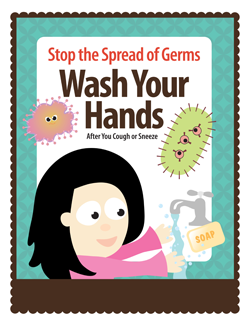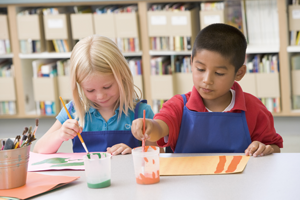By taking the simple step of implementing a hygiene program, schools can significantly cut their risk of illness.
Originally published in Cleaning & Maintenance Management Online
By Amanda Martini-Hughes

As the calendar turns from one year to the next, from December to January, we find ourselves in the thick of the cold and flu season.
It happens every year, but every year we seem to be caught off guard.
There are, however, plenty of ways to stave off the yearly crud, one of which begins with education.
A study conducted by Kimberly-Clark Professional over a period of seven months found that schools are extreme culprits of harboring and spreading germs that cause illnesses like the cold and flu.
With the help of the company, schools introduced hand hygiene and education programs and saw significant improvements in the levels of contamination within just a few months.
Recognizing A Problem
It’s not a new notion that schools can be great big breeding grounds for bacteria, in fact one of the worst culprits out there.
Students are in close contact with each other and their surroundings day in and day out, sharing everything from idle gossip to the toys at recess, which means that they are in close contact with the germs that their peers, and even teachers, may unknowingly be passing along.
Kimberly-Clark Professional recognized the impact that germ transmission can have on schools, both because of the illnesses that it can cause in students and teachers alike, but also because of how unchecked germs transmission can lead to absenteeism.
The study identified key germ “hot spots” in the schools and then went on to test the surface contamination of some of the most frequently touched objects in six elementary schools, utilizing adenosine triphosphate (ATP) testing to determine baseline contamination levels; those schools then implemented the Super Germ Fighters program, a customized educational program for students in kindergarten through fifth grade, along with The Healthy Classroom Station, which provides kid-friendly products in order to help teach students how to “wash, wipe and sanitize.”
Significant Findings
Initial contamination levels of the hot spots were surprising, with desks, door handles, water fountain handles, computer mice, bathroom stall door locks and cafeteria table being the top offenders.
However, throughout the seven months of the study, once proper practices and education were introduced those contamination levels dropped by impressive percentages, but better still, there was a significant increase in the students’ understands of germs and germ transmission, with teachers believing that understanding had increased by more than 300 percent.
This exemplified what we should have already known: Educating, from a young age, about the importance of good hygiene practices is extremely important.
“Good hygiene habits are instilled through education and engagement. Visual communication tools combined with lesson plans and the right product solutions will help motivate students to adopt good hygiene habits,” said Richard Marriott, education target market leader for Kimberly-Clark Professional.
“However, teacher engagement is equally important. To help promote the importance of proper hygiene practices, teachers need to have educational materials and tools available right in their classrooms.”
Having the right tools and educational materials will help drive the behavior changes that are necessary for any kind of significant reduction in germs or spread of germs.
Starting this education on an elementary school level is significant because it allows students to begin to develop these healthy habits at a young age.
“The study results demonstrate that providing young students with age-appropriate educational materials and products designed to instill good hygiene habits can have a profound effect on behaviors, which in turn can reduce germs inside and outside the classroom,” Marriot explained.
“These results are even more significant when you consider the impact that illnesses can have on students, parents and teachers.”
Student Driven Success
The Healthy Classroom Station used in the study was invented by students in the classroom, all based upon their feedback and interactions during the design process. Kimberly-Clark Professional found including the students in the design process was an important step because the product that was ultimately created was something that the students would like and would use, therefore supporting the program while also being fun, engaging and appropriate for the classroom environment.
Kimberly-Clark Professional found including the students in the design process was an important step because the product that was ultimately created was something that the students would like and would use, therefore supporting the program while also being fun, engaging and appropriate for the classroom environment.
Because the stations were something the students would actually use, they were engaged and able to learn more about how their own habits could impact those around them.
Schools alone, however, cannot fight the good fight against germs alone: The battle against germs, especially with young children, must be a two-front battle, both at school and at home.
“During our pilot study, 85 percent of parents said that hand hygiene should be an important part of the regular classroom lesson plan for their children. That said, ensuring these habits are reinforced at home, through both parental practice and communication is critical to ultimate success,” explained Dr. Kelly Arehart.
Healthy habits are usually learned at an early age and with their repeated success can be nurtured into adulthood, thus ensuring that the habit learned in childhood will continue to have a significant and lasting impact, not only on the individual, but on the health of those around them.
-----------------------------------------------------------------------------------------------------------------------
About the Author
Amanda Martini-Hughes is the assistant editor of Cleaning & Maintenance Management magazine. A graduate from Siena College, she can be reached at AMartini-Hughes@EBSCO.com. Since joining the publication, Martini-Hughes has worked on numerous industry articles and is responsible for populating the industry's only daily electronic newsletter, CM e-News Daily. Chat online: Facebook.com/CMMOnline and Twitter.com/CMeNewsDaily.
Source: http://www.cmmonline.com/articles/230101-school-is-in-session-so-are-germs
Read More:
Hand Hygiene Is As Easy As 1-2-3
Paper Towels vs. Hand Dryers
Hand Hygiene - Hand Towel Systems
Ask Sadie: It's Flu Season! How You Can Stay Healthy



